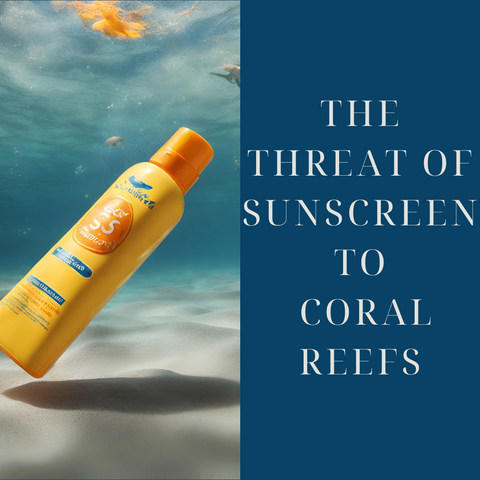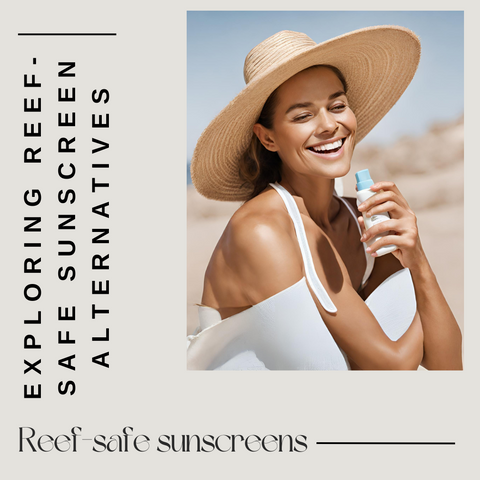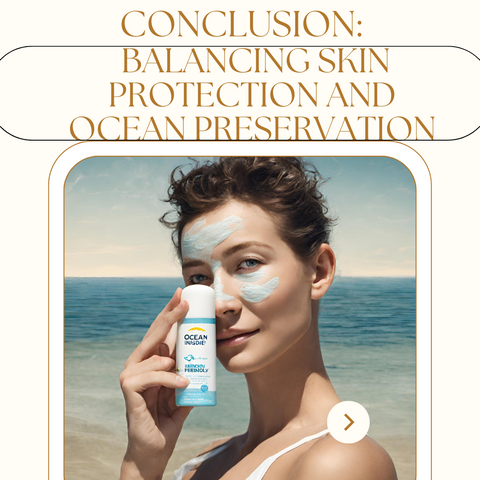Sunscreens, particularly those containing certain chemicals, can have negative environmental consequences, particularly for coral reefs. Chemical UV filters and nanoparticles are the two primary types of sunscreen chemicals linked to coral reef destruction. This blog provides an overview of sunscreen's environmental impact on coral reefs.
The Threat of Sunscreen to Coral Reefs

Some common compounds found in sunscreens are the main threat that sunscreens pose to coral reefs. While sunscreens are necessary for protecting human skin from damaging UV radiation, some of the components in these lotions can destroy coral reefs. Chemical UV filters and nanoparticles are the two primary types of sunscreen chemicals linked to coral reef destruction. Individuals must make informed decisions, support regulatory measures, and contribute to conservation initiatives that conserve these essential marine ecosystems to reduce the harm of sunscreen to coral reefs. Individuals can help the environment by using reef-safe sunscreen and using alternative sun protection techniques.
Identifying Harmful Chemicals in Sunscreens
Reading product labels and being aware of specific components that may have possible environmental or health risks are required to identify dangerous chemicals in sunscreens. These are some of the chemicals commonly found in sunscreens that have raised environmental and health concerns: oxybenzone (benzophenone-3), octinoxate (octyl methoxycinnamate), octocrylene, homosalate, avobenzone, nanoparticles (zinc oxide, titanium dioxide), parabens (e.g., methylparaben, propylparaben), phthalates (e.g. Individuals can choose sunscreens that are both effective for sun protection and environmentally friendly by being aware of these compounds and making informed choices. Reef-safe sunscreens frequently feature mineral-based blockers and do not contain some dangerous ingredients.
Understanding Coral Bleaching and its Causes
Coral bleaching occurs when corals lose their brilliant colors and turn white or pale due to the expulsion of symbiotic algae known as zooxanthellae. These algae reside in coral tissues and offer critical nutrients via photosynthesis. Coral bleaching is a stress response to different environmental variables that show the coral is in distress. Here's an explanation of coral bleaching and its causes, which include rising sea temperatures, ocean acidification, pollution, sun exposure, disease outbreaks, extreme weather events, overfishing, and genetic factors. Addressing the causes of coral bleaching necessitates global efforts to decrease pollution, mitigate climate change, and promote sustainable behaviors. Local conservation efforts, such as marine protected areas and coral reef restoration programmes, are also important in protecting coral reefs and building resilience.
The Role of Sunscreens in Marine Pollution
When sunscreen is used in aquatic environments, it can contribute to marine pollution. Certain compounds present in sunscreens, particularly those that are detrimental to marine life, including coral reefs, are the primary source of environmental concern. Here's an outline of sunscreen's influence on marine pollution:
-
Chemical Sunscreen Ingredients: Oxybenzone and Octinoxate are common chemical UV filters found in a wide range of sunscreens. According to research, when these chemicals are washed into the water, they can harm marine ecosystems.
- Impact on Coral Reefs: Coral bleaching has been linked to the chemicals oxybenzone and octinoxate, which can weaken and even kill coral reefs. These chemicals have the potential to disrupt the symbiotic relationship that exists between corals and zooxanthellae, resulting in coral stress and bleaching.
- Toxic Effects on Marine Life: Endocrine disruption has been linked to some sunscreen chemicals, such as oxybenzone, in marine organisms. This can have an impact on aquatic species' reproductive and developmental processes. Certain sunscreen ingredients can build up in the tissues of marine organisms, potentially leading to higher concentrations as they move up the food chain.
- Nanoparticles: While these mineral UV filters are generally considered safer for human use, in nanoparticle form, they can pose a risk to aquatic life. Nanoparticles can accumulate in the environment and have toxic effects on marine organisms.
- Runoff and Coastal Pollution: Beachgoers' and swimmers' sunscreen can wash into the water, adding to coastal pollution. Sunscreen residue from roads, sidewalks, and other surfaces can enter storm drains and end up in rivers, lakes, and seas.
- Impact on Phytoplankton: According to research, certain sunscreen compounds may have a harmful influence on phytoplankton, which are vital microorganisms that form the foundation of the marine food chain.
- Coral Restoration Challenges: Even when coral restoration efforts are underway, the use of certain sunscreens near coral nurseries can introduce harmful chemicals into the environment and impede recovery.
- Regulatory Responses: To protect coral reefs, some regions and countries have banned or restricted the sale and use of sunscreens containing oxybenzone and octinoxate.
- Consumer Awareness and Choices: As consumers become more aware of the environmental impact of sunscreens, the popularity of "reef-safe" or "reef-friendly" sunscreens that avoid harmful chemicals has grown.
-
Research and Innovation: Ongoing research is being conducted to develop sunscreens with biodegradable formulations that degrade more easily in the environment. Scientists are investigating alternative UV filters that are effective for sun protection without hurting the environment.
The environmental impact of sunscreens on marine pollution highlights the necessity of making informed decisions and supporting initiatives to safeguard aquatic ecosystems. Individuals can help save marine environments by using reef-safe sunscreen and practicing sensible sun protection.
Exploring Reef-Safe Sunscreen Alternatives

Reef-safe sunscreens are free of chemicals that are hazardous to coral reefs and marine life. Look for reef-safe sunscreen alternatives that use mineral-based UV filters and avoid toxic chemicals. Here are some crucial points to consider and alternatives:
-
Mineral-Based Sunscreens: Look for sunscreens that contain zinc oxide or titanium dioxide as active ingredients. These minerals form a physical barrier on the skin, reflecting and scattering UV rays. To reduce potential harm to marine life, use non-nanoparticle formulations.
-
Reef-Friendly Formulations: Reef-safe sunscreens are free of the chemicals oxybenzone and octinoxate, which are known to be harmful to coral reefs. Carefully read the ingredient list to ensure that no harmful chemicals are present.
-
Biodegradable Sunscreens: Some sunscreens are labelled as biodegradable, which means they degrade more quickly in the environment. Ingredients that are less likely to persist in aquatic ecosystems: Look for sunscreens that contain ingredients that are less likely to persist in aquatic ecosystems.
-
Water-Resistant Options: Select sunscreens that are labelled as water-resistant to reduce the amount of product that washes off into the water. Even if your sunscreen is water-resistant, you should reapply it after swimming or sweating.
-
Broad-Spectrum Protection: Make sure the sunscreen offers broad-spectrum UVA and UVB protection. Select an SPF (sun protection factor) that is appropriate for your needs and activities.
-
Cruelty-Free and Vegan Options: If animal welfare is a concern, look for cruelty-free sunscreens. Some sunscreens are made without the use of animal products.
-
Environmental Certifications: Some products have certifications indicating their environmental friendliness. Look for certifications such as "Reef Safe," "Eco-Friendly," or other relevant labels.
-
Non-Nano Particles: To reduce the risk of harming marine life, choose mineral-based sunscreen formulations with non-nano particles.
-
Packaging Considerations: Look for sunscreens with environmentally friendly packaging, such as recyclable or biodegradable materials.
-
Brand Reputation and Reviews: Investigate brands known for their commitment to sustainability and reef protection. Examine reviews and testimonials for feedback from other customers.
-
DIY Sunscreen Options: Some people prefer to make their sunscreen with natural ingredients such as coconut oil, shea butter, and zinc oxide. However, DIY formulations may not provide standardised protection, so proceed with caution and thorough research.
-
Community and Environmental Initiatives: Look for brands that actively support environmental initiatives and contribute to coral reef conservation efforts.
-
Consult Professional Advice: If you have specific skin concerns or sensitivities, consult with a dermatologist for personalised sunscreen recommendations.
Individuals can help protect coral reefs and marine ecosystems by making informed decisions and using reef-safe sunscreen. To make informed decisions for your skin and the environment, stay up to date on the latest developments in sunscreen formulations and environmental impact.
Characteristics of Biodegradable Sunscreens
Biodegradable sunscreens are made with components that degrade more quickly in the environment, lessening the possible impact on ecosystems. Natural and biodegradable ingredients, mineral-based UV filters, avoidance of harmful chemicals, water resistance, biodegradable packaging, no animal testing, natural fragrances and additives, broad-spectrum protection, biodegradability testing, environmental commitment, transparency, ingredient lists, and effectiveness are some key characteristics of biodegradable sunscreens. Choosing biodegradable sunscreens promotes environmentally responsible behavior and lowers the potential influence on marine habitats. It is critical to study product labels, understand the contents, and choose brands committed to sustainable and eco-friendly methods when purchasing such sunscreens.
Choosing Mineral-Based Sunscreens
Choosing mineral-based sunscreens entails picking products with active ingredients that contain physical UV filters such as zinc oxide or titanium dioxide. Mineral sunscreens are frequently favored over chemical sunscreens due to their broad-spectrum protection and lower environmental impact. Active ingredients, non-nano particles, broad-spectrum protection, reef-safe and biodegradable, water resistance, skin type and sensitivities, application and residue, brand reputation, environmental certifications, cruelty-free and vegan options, price and availability, expiration date, and travel-friendly packaging are all important factors to consider when selecting mineral-based sunscreens. When used in conjunction with other sun protection methods, sunscreen protects your skin from dangerous UV rays while minimising environmental effects.
Evaluating the Efficacy of Reef-Safe Products
Evaluating the performance of reef-safe goods, notably, sunscreens, entails taking into account a number of parameters to ensure adequate sun protection while minimising environmental damage. Active ingredients, broad-spectrum protection, water resistance, reef-safe certification, non-nano particles, biodegradability, avoidance of harmful chemicals, skin-friendly formulation, ingredient transparency, customer reviews, dermatologist recommendations, brand reputation, photostability, environmental impact, consistent application, and availability and price are all important factors to consider. Regularly examining and staying up to date on product formulas and consumer input helps to make educated decisions that are in line with both personal and environmental well-being.
Promoting Ocean-Friendly Sun Protection

Raising awareness about the impact of traditional sunscreens on marine ecosystems and encouraging the use of reef-safe alternatives are two ways to promote ocean-friendly sun protection. Educational campaigns, social media campaigns, collaborations with influencers, community workshops, and events, partnerships with environmental organisations, retailer and pharmacy partnerships, government and legislation support, school programmes, corporate sustainability initiatives, certifications and labels, public service announcements (PSAs), in-flight and travel industry partnerships are some of the strategies and messages used to promote ocean-friendly sun protection. Through the integration of these tactics, companies, associations, and people can support the advancement of reef-safe practises and the promotion of ocean-friendly sun protection. The intention is to raise public awareness and encourage a shift in consumer behavior towards selecting goods that safeguard marine ecosystems as well as human skin.
Steps for Sustainable Sun Care
Adopting sustainable sun care techniques entails making ecologically mindful decisions to preserve your skin while minimising your environmental impact. Choose reef-safe sunscreens, check for biodegradability, wear protective clothing, seek shade during peak hours, stay hydrated, think about sustainable packaging, DIY sunscreen options, support eco-friendly brands, reapply sunscreen responsibly, raise awareness, choose multifunctional products, dispose of them properly, consult with dermatologists, and advocate for sustainable practices. You may enjoy sun protection while minimising the environmental impact of your decisions if you incorporate these procedures into your sun care routine. Sustainable sun protection practices benefit both people and the environment.
Legislative and Conservation Efforts
Legislative and conservation initiatives are critical to maintaining marine ecosystems, especially when it comes to addressing the environmental impact of sunscreens on coral reefs. Legislation prohibiting harmful chemicals, reef protection acts, education, and outreach programmes, international collaboration, certifications and standards, scientific research and studies, advocacy for sustainable practices, corporate initiatives, community engagement, government incentives for sustainable products, sunscreen ingredient regulation, and partnerships with the tourism industry are some notable legislative and conservation initiatives and measures. Governments and organisations can work together to protect coral reefs and promote sustainable sun care habits by combining legislative measures, public awareness campaigns, and collaborative projects.
Educating the Public on Ocean-Safe Practices
Educating the public on ocean-safe practises is critical for raising awareness and encouraging responsible behavior that protects marine ecosystems. Digital and social media campaigns, interactive workshops and webinars, community events, partnerships with local businesses, multilingual outreach, public service announcements (PSAs), educational apps and games, printed materials and brochures, stakeholder engagement, storytelling, regular news features, encouraging responsible tourism, and the use of visual documentation are some of the strategies and approaches used to effectively educate the public on ocean-safe practises. Communities can contribute to a collective effort to protect and preserve our oceans for future generations by implementing these strategies.
Conclusion: Balancing Skin Protection and Ocean Preservation

In our combined efforts to protect both human health and marine ecosystems, we must strike a delicate balance between skin protection and ocean preservation. As we work to protect our skin from the detrimental effects of UV radiation, we must also adopt techniques and products that have a low impact on the fragile underwater world. Traditional sunscreens containing hazardous chemicals have been discovered as a major threat to coral reefs and marine life. Oxybenzone and octinoxate, which are often present in sunscreens, have been related to coral bleaching, DNA damage in corals, and disturbances in marine organism development. Recognising this, a transition towards reef-safe alternatives, such as mineral-based treatments including zinc oxide or titanium dioxide, is critical.
Education is critical to bringing about this shift. Giving people information about the environmental repercussions of their choices creates a sense of responsibility. Public awareness campaigns, instructional workshops, and cooperation with schools and businesses all contribute to a better understanding of the relationship between personal actions and the health of our seas. Furthermore, legislative actions prohibiting or restricting the use of dangerous sunscreen ingredients, together with environmental organisations' advocacy, are critical steps in minimising the impact on coral reefs. These regulatory measures send a strong message to the cosmetics and skincare industries about the importance of prioritising ocean-friendly methods. Adopting a holistic approach to sun care as a consumer entails considering not only personal well-being but also the broader environmental implications of the products we select. Sustainable sun care practises, such as wearing protective clothing, seeking shade, and supporting eco-friendly brands, contribute to a comprehensive skin protection and ocean preservation strategy.















